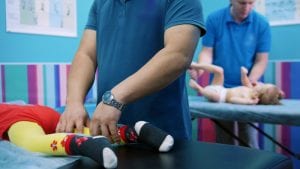
Cerebral palsy is a group of diseases that impacts the brain. The ailment typically develops during fetal development or during the first several years of a young person’s life.
This medical condition can present challenges to parents of infants born with this disorder.
Cerebral Palsy Causes
While physicians and scientific researchers opine that the ailment is caused by interrupted brain development, they cannot pinpoint an exact cause. These medical professionals suggest the malady might be precipitated by issues like infections the child’s mother possessed that spread during fetal development, genetic mutations, traumatic brain injury such as might be sustained during a fall, shaken baby syndrome, a motor vehicle accident, or lack of oxygen that may occur during challenging labor.
Possible Risk Factors
Certain issues impacting both mother and baby could precipitate the condition. In mothers, it could be exposure to various viruses and sexually transmitted diseases. Fetuses exposed to maladies like jaundice and certain infections stand at greater risk of developing the ailment. Additionally, low birth weight and premature birth could increase a child’s chances.
Physical Manifestations
 Symptoms often vary from case to case and with severity. However, many manifestations correlate to deficient muscular coordination and motor skills. More specifically, occurrences might include muscle stiffness and rigidity, hearing and vision disturbances, chewing, swallowing and eating problems, mobility challenges, breathing issues, learning disabilities, bowel and bladder control issues, tooth decay, bone weakness, acid reflux disease, and speech struggles.
Symptoms often vary from case to case and with severity. However, many manifestations correlate to deficient muscular coordination and motor skills. More specifically, occurrences might include muscle stiffness and rigidity, hearing and vision disturbances, chewing, swallowing and eating problems, mobility challenges, breathing issues, learning disabilities, bowel and bladder control issues, tooth decay, bone weakness, acid reflux disease, and speech struggles.
Diagnosis
A doctor might suspect cerebral palsy if a baby or toddler displays potential early red flag symptoms such as muscle spasms, poor posture, decreased muscle tone, feeding or eating problems, favoring one side of the body, the inability to walk by 12 to 18 months or limited capacity to speak simple sentences by 24 months.
The diagnostic process is not always cut and dry, because the condition can mimic a variety of other illnesses and is not typically precipitated by one obvious cause. In certain instances, a doctor might employ diagnostic tools like computerized tomography, CT scans or magnetic resonance imaging (MRI) to examine the brain. However, even such technologically advanced testing does not necessarily lead to any smoking-gun conclusions, and an official diagnosis could take months or possibly years and necessitate visits to various medical specialists.
Possible Treatment Options
Unfortunately, there is no cure for cerebral palsy. However, physicians can employ various therapeutic protocols designed to ease the symptoms and improve the child’s life quality. Specific treatments, however, depend on a variety of factors such as the specific symptoms the child is stricken with and the symptoms’ severity. Remedial endeavors might include the following:
- Physical Therapy – This form of treatment helps prevent muscle wasting and might improve the patient’s mobility.
- Speech Therapy – This activity can not only improve the afflicted child’s speaking abilities but help him or her strengthen the throat and jaw muscles, which could reduce incidents of drooling or eating problems.
- Occupational Therapy – This therapy is geared toward helping impacted young people gain a better grasp of performing daily tasks like dressing themselves or performing scholastic functions when they reach school age.
- Assistive Devices – Assistive devices like leg braces, motorized chairs or computer software might improve some patients’ mobility and speech.
- Medications – A variety of drugs might be prescribed to control any number of symptoms.
- Surgery – Children with severe manifestations of muscle rigidity might benefit from surgical procedures designed to lengthen and strengthen soft tissues like tendons. This could improve mobility and ease associated pain.
Special Care Tips
Raising a child diagnosed with cerebral palsy can be extremely challenging. Parents facing these difficult circumstances are encouraged to deal with their own emotions and understand that it is okay to feel sad or angry. However, they are also urged to realize that, with the proper assistance, their children can still lead relatively productive and meaningful lives.


